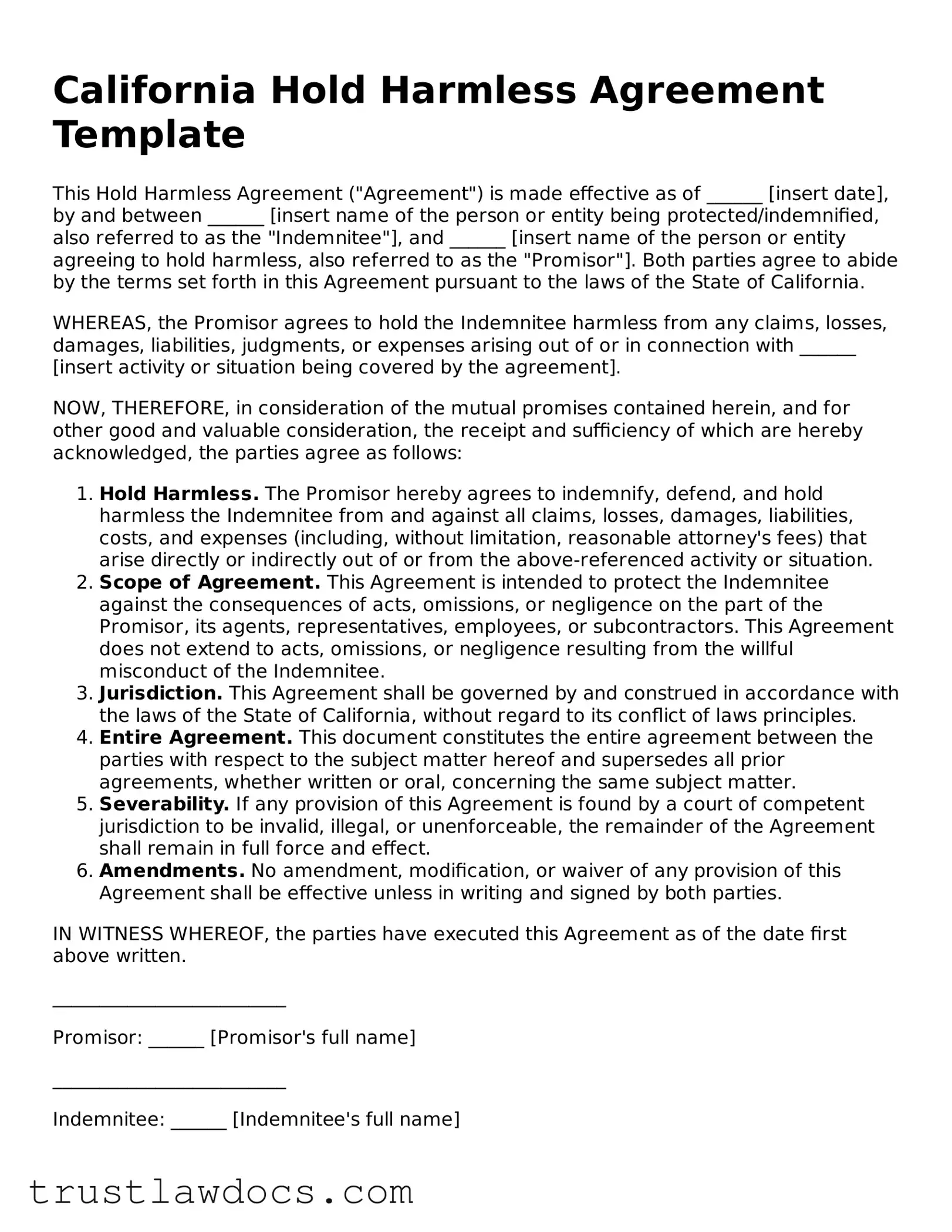What is a California Hold Harmless Agreement?
A California Hold Harmless Agreement is a legal document that shifts liability from one party to another. It protects one party from legal consequences or liabilities arising from the actions of another party. This agreement is commonly used in construction, real estate, and event planning, ensuring that one party will not be held responsible for certain risks and damages.
Who needs a California Hold Harmless Agreement?
Individuals or businesses involved in situations where they want to be protected from potential legal claims or liabilities often need a Hold Harmless Agreement. This includes contractors, property owners, event organizers, and businesses that offer potentially hazardous activities. It's particularly pertinent when one party is taking on risks that typically belong to another party.
Are Hold Harmless Agreements enforceable in California?
Yes, Hold Harmless Agreements are generally enforceable in California. However, their enforceability can depend on the specific circumstances surrounding the agreement. For instance, agreements that are overly broad or vague, or those that involve indemnity for one's negligence, may face scrutiny under California law. The fairness of the agreement and the clarity of its terms are critical for enforceability.
What should be included in a Hold Harmless Agreement?
A comprehensive California Hold Harmless Agreement should include a clear definition of the scope of liability being transferred, the duration of the agreement, specifics of the parties involved, and any exceptions to the hold harmless clause. It may also detail the types of claims covered, such as property damage or personal injury, and any financial caps on the liability.
Can I write a Hold Harmless Agreement myself?
While it is possible to draft a Hold Harmless Agreement yourself, consulting with a legal professional is highly advisable. This ensures that the agreement complies with California law and effectively protects your interests. A poorly drafted agreement may not offer the protection you expect and could be deemed unenforceable.
Is a Hold Harmless Agreement the same as an indemnity agreement?
Although similar, there is a distinction between a Hold Harmless Agreement and an indemnity agreement. An indemnity agreement typically requires one party to compensate another for the losses incurred due to the actions of the indemnifier or another party. A Hold Harmless Agreement generally releases one party from legal liability for damages. In practice, many agreements combine elements of both indemnification and hold harmless provisions.
How long does a Hold Harmless Agreement last?
The duration of a Hold Harmless Agreement can vary. It may last for a specific project, event, or period, or it may encompass an ongoing relationship. The term should be explicitly stated within the agreement to avoid any ambiguity. Extension or termination conditions may also be included.
Can a Hold Harmless Agreement be terminated?
Yes, a Hold Harmless Agreement can be terminated, but the conditions for termination must be clearly outlined in the agreement itself. This may include mutual consent of the parties, completion of the project or event, or a breach of the agreement’s terms. Termination clauses are vital for ensuring that both parties understand under what circumstances the agreement can end.
Does a Hold Harmless Agreement cover all types of risks?
No, a Hold Harmless Agreement may not cover all types of risks. The scope of risks and liabilities covered depends on how the agreement is written. Certain types of negligence or intentional wrongdoing may not be protected under the agreement. It's important to specify which risks are covered and any exceptions within the document.
Where can I get a Hold Harmless Agreement form for California?
Hold Harmless Agreement forms for California can be obtained from legal document services, attorneys specializing in California law, or by drafting a custom agreement with legal guidance. Utilizing a template from a reputable source can be a starting point, but customization may be necessary to address your specific situation adequately.
